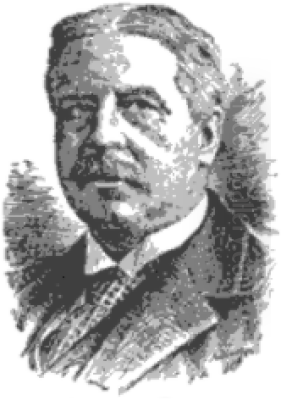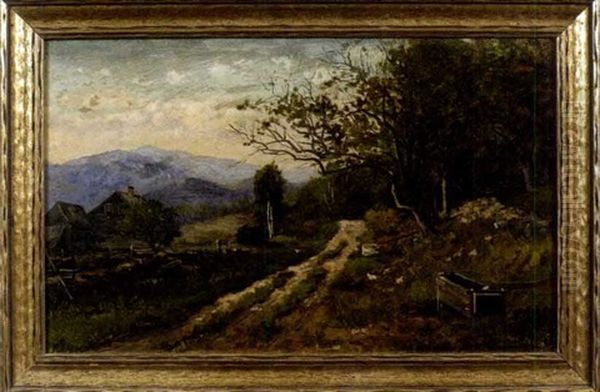
Frank Henry Shapleigh stands as a significant figure in late 19th-century American landscape painting. Active during a period of burgeoning national identity and increased appreciation for the American wilderness, Shapleigh carved a distinct niche for himself, primarily known for his evocative depictions of the White Mountains of New Hampshire and the historic landscapes of St. Augustine, Florida. His work, characterized by a direct, observational style and often imbued with a sense of quiet intimacy, provides a valuable visual record of these regions during a time of transformation and growing tourism.
Early Life and Artistic Formation
Born in Boston, Massachusetts, in 1842, Frank Henry Shapleigh began his artistic journey in his hometown. He received foundational training at the Lowell Institute of Drawing, an institution that provided practical artistic education to many aspiring Boston artists. This early exposure to structured drawing and composition laid the groundwork for his future career.
Seeking to broaden his artistic horizons, Shapleigh traveled to Europe between 1867 and 1868. This period was crucial for his development. He spent significant time in Paris, the epicenter of the art world at the time. There, he sought instruction from Emile Lambinet, a respected French landscape painter associated with the Barbizon School. Studying with Lambinet exposed Shapleigh to the Barbizon ethos, which emphasized direct observation of nature, realistic depiction of rural life, and often featured looser brushwork and a focus on atmospheric effects compared to stricter academic styles. This influence tempered his American sensibilities and likely encouraged his commitment to painting en plein air or developing sketches made outdoors. Artists like Jean-Baptiste-Camille Corot and Jean-François Millet were central figures of the Barbizon movement, championing a move away from idealized historical landscapes towards a more grounded portrayal of the countryside.
The White Mountains Beckon

Upon returning to the United States, Shapleigh was drawn to the majestic scenery of the White Mountains in New Hampshire. This region had already captivated an earlier generation of American artists associated with the Hudson River School, such as Thomas Cole and Asher B. Durand, who sought sublime and picturesque beauty in the American wilderness. By the time Shapleigh became active, the White Mountains had evolved into a major center for landscape painting and a popular tourist destination.
Artists flocked to the area, particularly around North Conway, Jackson, and the Crawford Notch, establishing a distinct regional movement often referred to as the White Mountain School. Benjamin Champney is frequently credited as one of the earliest and most influential figures in popularizing the area among artists. Shapleigh arrived as this tradition was well-established, joining a vibrant community of painters who captured the region's unique character.
Residency at the Crawford House
Shapleigh's connection to the White Mountains deepened significantly in 1877 when he began a long tenure as the artist-in-residence at the Crawford House. Located strategically near the dramatic Crawford Notch, this grand hotel was a hub for tourists eager to experience the mountain scenery. Shapleigh maintained his residency there for sixteen consecutive summers, until 1893. This position provided him with both a steady base of operations and direct access to patrons among the hotel guests.
His studio at the Crawford House became a well-known feature, a place where visitors could see the artist at work and purchase views of the surrounding landmarks they had just visited. Remarkably, this studio building survives to this day, preserved near the site of the original hotel (which burned down) and now part of the Appalachian Mountain Club's Highland Center, serving as a tangible link to Shapleigh's era. During his time there, he painted countless views of the Notch, Mount Washington, the Saco River, and other local beauty spots, often fulfilling the demand for scenic souvenirs.
The White Mountains during Shapleigh's time were a magnet for numerous talented artists. While some, like the renowned Albert Bierstadt, made occasional, spectacular painting trips, others, like Shapleigh, developed a more sustained relationship with the region. Contemporaries who also painted the White Mountains include Hudson River School masters like Sanford Robinson Gifford and John Frederick Kensett, as well as Jasper Francis Cropsey, Alfred Thompson Bricher, Aaron Draper Shattuck, Samuel Lancaster Gerry, Samuel W. Griggs, and George Loring Brown, each bringing their own style to the shared subject matter.
Winter Seasons in St. Augustine
Complementing his summers in the cool mountains, Shapleigh established a pattern of spending his winters in the warmer climate of St. Augustine, Florida. This practice was common among artists and affluent Northeasterners seeking refuge from the cold. St. Augustine, with its rich history, Spanish colonial architecture, and coastal setting, offered a completely different visual vocabulary compared to the rugged peaks of New Hampshire.
Shapleigh secured a position as an artist-in-residence at the opulent Ponce de Leon Hotel, a lavish resort built by the industrialist Henry Flagler, which opened in 1888. Flagler actively encouraged artists to work in his hotels, recognizing their presence added cultural cachet and provided desirable souvenirs for his wealthy guests. Shapleigh maintained a studio there during various winter seasons, notably from 1886-1887 (likely at Flagler's earlier Hotel Alcazar initially) and then more consistently at the Ponce de Leon from around 1889 until 1902.
In Florida, his subjects shifted to the city's old gates, narrow streets, Matanzas Bay, the Castillo de San Marcos, and local flora. He became a recognized figure in the St. Augustine art scene. This winter migration brought him into contact with other artists drawn to Florida's unique appeal, including the celebrated luminist painter Martin Johnson Heade, known for his depictions of Florida marshes and flowers, as well as figures like Alfred Fuller Graves and potentially others like William Aiken Walker, known for his scenes of Southern life.
A Distinctive Artistic Style
Frank Henry Shapleigh developed a recognizable and personal style that set him apart. While clearly skilled and well-trained, his work often possesses a directness and lack of pretension sometimes described as "primitive" or naive, though perhaps "unadorned realism" is a more accurate term. He seemed less interested in the dramatic atmospherics of some Hudson River School painters or the overt romanticism found in European academic art.
One of his most characteristic compositional devices was painting views from an interior, looking out through a window or doorway. He frequently depicted scenes framed by the dark interiors of barns, kitchens, or sitting rooms, often including details of domestic life within the foreground. This technique creates a sense of intimacy and personal perspective, placing the viewer within a sheltered space while contemplating the landscape beyond. It also allowed him to explore contrasts of light and shadow between the interior and the exterior view.
Shapleigh also became known for his repeated use of certain props within these interior scenes. Objects like a specific rocking chair, a cat (often sleeping), woven baskets, a discarded straw hat, or a simple ladder appear in multiple paintings across different locations and years. These recurring elements add a touch of narrative, domesticity, and personal signature to his work, grounding the sometimes grand landscapes in everyday reality.
His palette generally favored naturalistic colors, capturing the specific light and atmosphere of the location, whether the crisp air of the White Mountains or the humid haze of Florida. His brushwork was typically controlled and descriptive, focusing on rendering details accurately without excessive flourish.
Chronicler of Place
A notable aspect of Shapleigh's practice was his habit of carefully inscribing the titles and locations of his paintings on their reverse sides. This meticulous documentation provides invaluable information for art historians and researchers today, confirming the specific views he depicted and offering insights into popular tourist itineraries of the late 19th century. His work serves not just as art, but as a historical record of specific places at a particular moment in time.
He painted many of the most famous landmarks of his chosen regions. In New Hampshire, Mount Washington, Tuckerman Ravine, Echo Lake, and the vistas of Crawford Notch were frequent subjects. In Florida, the City Gates of St. Augustine, Fort Marion (Castillo de San Marcos), and views along the Matanzas River appear regularly in his oeuvre. He captured these popular sites with an eye for their recognizable features, catering to the desire of visitors to take home a memento of their travels.
Representative Works
While a comprehensive list is extensive, certain titles and types of scenes are representative of Shapleigh's output. Works like Thorn Road, Jackson, New Hampshire capture the rural charm and specific topography of the White Mountains region. Paintings titled The River At St. Augustine, Fla. or Matanzas Bay, St. Augustine, Florida (an 1874 example exists) showcase his engagement with the Floridian landscape, focusing on its waterways and coastal character.
His interior-exterior views are perhaps his most iconic. A work like Mt Chocorua from Old Barn, Eaton, N.H. exemplifies this approach, using the rustic structure of the barn to frame the distant peak, often including details like hay bales or farm tools in the foreground. Similarly, views from the Crawford House studio window were a recurring theme. While less common, paintings like An English Farmhouse at Kenilworth suggest occasional work inspired by his European travels or perhaps depicting specific architectural styles found in America. His dedication to specific locations means many works bear titles directly referencing places like "Crawford Notch," "Ellis River," or "Old City Gates, St. Augustine."
Later Life and Maple Knoll
Towards the end of his career, Shapleigh solidified his deep connection to New Hampshire. In 1896, he built a permanent summer home and studio in Jackson, naming it "Maple Knoll." This move signaled his transition away from the hotel-based residency model towards a more settled existence in the region he loved most. He continued to paint the surrounding landscapes from this base during the warmer months, spending his final years immersed in the scenery that had defined much of his artistic life. He passed away in Jackson in 1906.
Legacy and Historical Evaluation
During his lifetime, Frank Henry Shapleigh was a respected and commercially successful artist. His residencies at prominent hotels ensured visibility, and his accessible style and recognizable subject matter appealed to the growing tourist market. His paintings were acquired by visitors from across the country, spreading his reputation.
Historically, he is firmly placed within the White Mountain School of painting, considered one of its significant later practitioners. While perhaps not as innovative as some of the pioneering Hudson River School figures or as internationally famous as contemporaries like Winslow Homer or John Singer Sargent, Shapleigh's contribution is substantial. He captured the character of specific American regions with honesty and charm.
His work continues to be sought after by collectors, particularly pieces depicting iconic White Mountain or St. Augustine views, and especially his signature interior-framed landscapes. Auction results, such as the reported sale of a St. Augustine scene for over $100,000, attest to his enduring market appeal and historical significance. His paintings offer more than just aesthetic pleasure; they serve as valuable documents of late 19th-century American landscape, tourism, and regional identity.
Conclusion
Frank Henry Shapleigh's art provides a fascinating window into late 19th-century America. As a dedicated landscape painter, he skillfully documented the distinct environments of the New Hampshire White Mountains and coastal Florida. Through his long-term residencies and characteristic style, particularly his intimate interior-framed views and meticulous titling, he created a body of work that is both artistically appealing and historically informative. He remains an important figure for understanding the development of American landscape painting and the cultural life surrounding the nation's burgeoning tourist destinations. His paintings continue to resonate with viewers who appreciate his direct, heartfelt connection to the places he depicted.